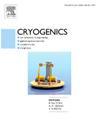Cooling system for DIXE mission from 300 K to 4 K
IF 2.1
3区 工程技术
Q3 PHYSICS, APPLIED
引用次数: 0
Abstract
The Diffuse X-ray Explorer (DIXE) is a high-resolution X-ray spectroscopic surveyor, planned to be mounted on the China Space Station. Its primary goal is to study the origin and evolution of hot baryons in the Milky Way. The Transition Edge Sensors (TES) detectors require an operating temperature below 100 mK to ensure excellent energy resolution. A two-stage Adiabatic Demagnetization Refrigerator (ADR) is incorporated into the system to achieve this ultra-low temperature. The two-stage thermally coupled pulse tube cryocooler (PTC) and the 4He Joule-Thomson cryocooler (JTC) provide the 4 K heat sink for the ADR. This paper describes the design of the DIXE cryogenic experimental system and the operational results of cooling from 300 K to 4 K. The total input electrical power for the PTC and JTC is 604.88 W. The evaporator temperature of the JTC operates stably at 4.33 K, ensuring the proper functioning of a two-stage ADR.
DIXE任务的冷却系统从300k到4k
漫射x射线探测器(DIXE)是一种高分辨率x射线光谱探测器,计划安装在中国空间站上。它的主要目标是研究银河系中热重子的起源和演化。过渡边缘传感器(TES)探测器需要低于100 mK的工作温度,以确保出色的能量分辨率。该系统采用了两级绝热消磁制冷机(ADR)来实现这种超低温。两级热耦合脉冲管制冷机(PTC)和4He焦耳-汤姆逊制冷机(JTC)为ADR提供了4k的散热器。本文介绍了DIXE低温实验系统的设计和从300 K冷却到4 K的运行结果。PTC和JTC的输入总功率为604.88 W。JTC蒸发器温度稳定在4.33 K,保证了两级ADR的正常运行。
本文章由计算机程序翻译,如有差异,请以英文原文为准。
求助全文
约1分钟内获得全文
求助全文
来源期刊

Cryogenics
物理-热力学
CiteScore
3.80
自引率
9.50%
发文量
0
审稿时长
2.1 months
期刊介绍:
Cryogenics is the world''s leading journal focusing on all aspects of cryoengineering and cryogenics. Papers published in Cryogenics cover a wide variety of subjects in low temperature engineering and research. Among the areas covered are:
- Applications of superconductivity: magnets, electronics, devices
- Superconductors and their properties
- Properties of materials: metals, alloys, composites, polymers, insulations
- New applications of cryogenic technology to processes, devices, machinery
- Refrigeration and liquefaction technology
- Thermodynamics
- Fluid properties and fluid mechanics
- Heat transfer
- Thermometry and measurement science
- Cryogenics in medicine
- Cryoelectronics
 求助内容:
求助内容: 应助结果提醒方式:
应助结果提醒方式:


